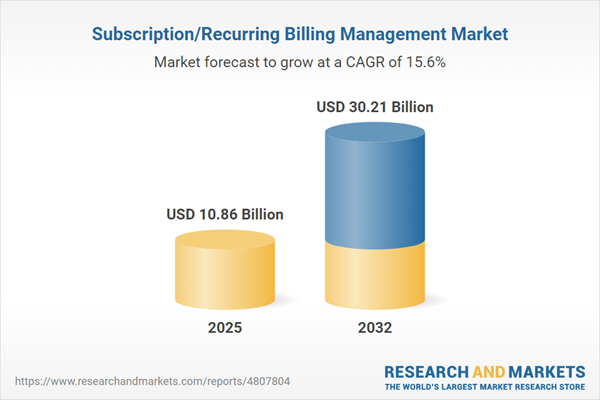Speak directly to the analyst to clarify any post sales queries you may have.
Subscription and recurring billing management is transforming the landscape for digital-first enterprises, enabling predictable revenue streams and deeper customer engagement through seamless, scalable billing experiences. As organizations aim for growth amid evolving regulatory and technology demands, mastering this market is more critical than ever for leadership teams in finance, IT, and operations.
Market Snapshot: Subscription/Recurring Billing Management Market
The Subscription/Recurring Billing Management Market grew from USD 9.46 billion in 2024 to USD 10.86 billion in 2025 and is projected to reach USD 30.21 billion by 2032, achieving a CAGR of 15.61%.
This robust trajectory reflects the global shift to digital monetization models, powered by investments in automation, analytics, and modern cloud architectures. Senior executives are increasingly focused on resilient, adaptable billing solutions that accommodate regulatory shifts and shifting user expectations across all regions and verticals.Scope & Segmentation of the Subscription/Recurring Billing Management Market
- Component: Services (Consulting, Implementation & Integration, Support & Maintenance), and Software modules (Payment Gateway Integration, Pricing & Quote Management, Recurring Billing Engine, Revenue Recognition & Accounting, Subscription Order Management)
- Business Model: B2B, B2C, and D2C operations
- Billing Type: Flat Rate, Per User, Tiered Pricing, Usage Based
- Deployment Model: Cloud and On Premise platforms
- Application: Analytics & Reporting, Billing Automation, Revenue Management, Subscription Lifecycle Management
- Enterprise Size: Large Enterprises and Small & Medium Enterprises (SMEs)
- Industry Vertical: Banking, Financial Services & Insurance (BFSI), eCommerce & Retail, Education, Healthcare & Wellness, IT & Telecommunication, Media & Entertainment, Travel & Hospitality
- Region: Americas (North America, Latin America), EMEA (Europe, Middle East & Africa), Asia-Pacific
Key Market Segmentation Relevance
These segments drive tailored solution development, from the modular needs of large enterprises and regulated industries to the ease-of-use demands in SME adoption. Fintech, healthcare, and retail verticals require customized compliance and payment integrations, while Asia-Pacific’s mobile-first environment demands real-time, flexible billing schemes. The B2B sector targets complex usage analytics, whereas D2C channels focus on brand-focused engagement and seamless onboarding.
Key Takeaways for Senior Decision-Makers
- Subscription/recurring billing management platforms enable organizations to deliver consistent user experiences, simplify onboarding, and fuel loyalty through transparency and convenience.
- The continued rise of cloud-native architectures and open APIs promotes scalability, resilience, and rapid integration with CRM and ERP tools, supporting unified revenue management and faster deployment of product iterations.
- Advanced analytics and artificial intelligence embedded in billing workflows empower businesses to personalize pricing, predict churn, and optimize campaign performance, driving overall customer and revenue value.
- Evolving compliance requirements and shifting tax regimes necessitate integrated security, privacy, and localization features, with reporting tools that ensure ongoing regulatory alignment across geographies.
- Diversifying payment options—including digital wallets and buy now, pay later—reflects increased focus on frictionless, user-driven transactions in saturated and emerging markets alike.
- Functional consolidation, such as the bundling of subscription management with broader ERP and financial applications, allows organizations to achieve end-to-end visibility and streamlined operations.
Tariff Impact: Navigating New Regulatory and Cost Pressures
Recent changes in United States tariffs have introduced cost variability, primarily affecting data center hardware, semiconductor imports, and specific software licensing. Many enterprises are responding by re-negotiating supplier contracts, optimizing technology sourcing, and leveraging edge computing to manage infrastructure costs more effectively. This situation highlights the importance of agile, dynamic billing engines that can adjust surcharges, taxes, and contractual pricing models in real time, ensuring financial resilience and operational agility.
Methodology & Data Sources
This report synthesizes insights from structured interviews with industry executives, finance leaders, and technology experts. Quantitative data was derived from standardized online surveys, while secondary sources such as industry publications and regulatory filings provided additional validation. Data triangulation, trend analysis, and ongoing expert workshops ensure actionable, reliable intelligence for every stakeholder.
Why This Report Matters
- Enables strategic decision-making by equipping senior leaders with actionable insights into key trends, regulatory risks, and market best practices.
- Supports technology and procurement planning by mapping the competitive landscape and spotlighting innovations in automation, integration, and compliance.
- Guides revenue optimization and customer retention strategies with empirical evidence across segments, deployment models, and regional preferences.
Conclusion
Subscription and recurring billing management stands as a strategic lever for organizations seeking sustainable growth and operational agility. By integrating next-generation technology and compliance standards, industry leaders can confidently evolve their billing ecosystems and maximize long-term customer value.
Additional Product Information:
- Purchase of this report includes 1 year online access with quarterly updates.
- This report can be updated on request. Please contact our Customer Experience team using the Ask a Question widget on our website.
Table of Contents
3. Executive Summary
4. Market Overview
7. Cumulative Impact of Artificial Intelligence 2025
Companies Mentioned
The companies profiled in this Subscription/Recurring Billing Management market report include:- Zuora, Inc.
- ChargeBee, Inc.
- ActivePlatform
- Amazon.com, Inc.
- Aria Systems, Inc.
- Billwerk+ Germany GmbH
- BluSynergy
- Cerillion PLC
- Cleverbridge AG
- Conga Corporation
- DXC Technology Company
- FastSpring
- FreshBooks
- Gotransverse LLC
- LogiSense Corporation
- MoonClerk LLC
- Oracle Corporation
- PayPal, Inc.
- Recurly, Inc.
- Salesforce.com, Inc.
- SAP SE
- SOFTRAX Inc.
- Stripe, Inc.
- VeriFone Holdings, Inc.
- Zoho Corporation Pvt. Ltd.
- Worldline S.A.
Table Information
| Report Attribute | Details |
|---|---|
| No. of Pages | 189 |
| Published | October 2025 |
| Forecast Period | 2025 - 2032 |
| Estimated Market Value ( USD | $ 10.86 Billion |
| Forecasted Market Value ( USD | $ 30.21 Billion |
| Compound Annual Growth Rate | 15.6% |
| Regions Covered | Global |
| No. of Companies Mentioned | 27 |









